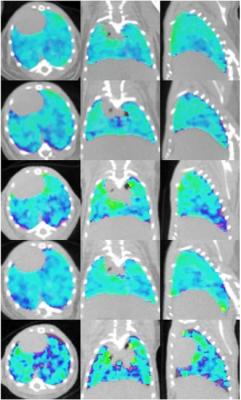
April 3, 2013 — In vivo ventilation/perfusion (V/Q) imaging can detect early changes to the lung caused by cigarette smoke exposure and provides a noninvasive method for studying lung dysfunction in preclinical models, according to research published in the April issue of The Journal of Nuclear Medicine. These measures have the potential to be applied clinically to study and diagnose the early stages of chronic obstructive pulmonary disease (COPD).
“Our preclinical study suggests that not only can V/Q imaging detect early and small changes in lung pathology, the type of V/Q mismatching could provide insight into the underlying pathologies, which current measures of lung function are unable to do,” said N. Renee Labiris, Ph.D., one of the authors of the study “Detection of Lung Dysfunction Using Ventilation and Perfusion SPECT in a Mouse Model of Chronic Cigarette Smoke Exposure.”
In the study, groups of mice were exposed to cigarette smoke for 50 minutes twice daily, five days a week, for either eight or 24 weeks. Age-matched control groups of mice were also included in the study for comparison. After the final cigarette smoke exposure, V/Q single photon emission computed tomography (SPECT) was performed, followed by a computed tomography (CT) scan. Histologic lung sections were then collected and a semiautomated quantitative analysis of airspace enlargement was applied to whole histology slices.
Upon analysis, functional impairment was noted in the lungs due to increased inflammation and airspace enlargement. This functional impairment, measured with SPECT V/Q imaging, identified COPD characteristics before CT was able to detect structural changes in the lungs. In addition, V/Q mismatching progressively increased during cigarette smoke exposure in mice compared to age-matched control mice and offered insight into the underlying pathology causing COPD.
“V/Q imaging is a common nuclear medicine technique, and SPECT/CT systems are increasingly used in clinical practice,” said Labiris. “As such, the technology examined in this study can be carried out in both preclinical and clinical settings, enabling researchers to translate preclinical investigations of disease, associated functional abnormalities and future drug targets into an improved understanding and management of the disease in patients.”
For more information: www.snmmi.org


 July 30, 2024
July 30, 2024 








